Story and photos by Louisa Evers
As Ada County’s Expo Idaho Citizens Advisory Committee wrestles with what should be next for the 240-acre site in Garden City, the Boise River Enhancement Network (BREN) has been enlisting birders to visit the Les Bois racetrack site to gather information about what birds use the area. The information will be shared with the committee and Ada County. Expo Idaho and the Les Bois racetrack contain important habitat types, some that are increasingly rare in the middle of a highly developed area.
The infield contains a pond with a marshy perimeter, shrubs, and grassy areas with a few trees. The flat track is habitat for certain types of birds. Another major habitat type are the trees and shrubs on the east side of the track close to the Boise River and on the main grounds of Expo Idaho. Lastly are the many buildings, including the grandstands, administrative buildings, and livestock areas.
The track and stables are closed to the public. Through BREN, birders gained access to this area in February, July, and October. 53 species have been documented within or near the infield. This blog discusses birds that are present year-round, present primarily in summer, and present primarily in winter.
Year-round Birds
Visitors to the infield can expect to find at least 28 species at any time of the year. Birds typically found around the buildings include rock pigeon, Eurasian collared-dove, mourning dove, European starling, house finch, and house sparrow. Of these, the pigeon, collared-dove, starling, and house sparrow are not native to the U.S. All these species are very tolerant of people, very common, and often will nest in our structures, such as the grandstands. However, there is a diversity of species indicative of a healthy ecosystem and often lacking in urban areas.
Birds typically found in the nearby trees and shrubby areas include Cooper’s hawk, California quail, northern flicker, downy woodpecker, black-capped chickadee, and song sparrow. These birds depend on trees and shrubs for food, cover, and nesting sites. Most of these are relatively small birds and may be heard before they are seen. Cooper’s hawk and northern flicker are relatively large birds and may be seen before they are heard. Cooper’s hawk is an accipiter, which means they specialize in hunting other birds and are adapted to maneuvering through forest.
A different group of birds are found in the pond and marshy area. As might be expected, Canada goose, mallard, and double-crested cormorant are the most common residents. American coots and pied-billed grebes use the pond, but tend to be more commonly seen in winter than summer. Red-winged blackbirds nest in the marshy area. The pond is relatively small, so the numbers of each species may also be small.
Several species use multiple parts of the site. Killdeer can use the shorter grasses and the track itself and possibly the area around the stables for nesting and foraging, although the presence of red foxes may affect nesting success. Killdeer do not build a nest, instead laying their eggs in a shallow depression in open areas. Ring-billed and California gulls fly over the site and perch on top of the buildings, in short grasses, on the track, or in other open areas. Great blue herons use the pond, marsh, and infield at various times for hunting. Red-tailed hawks typically nest in the nearby trees and hunt the open areas.
Belted kingfishers fish the pond, but nest in banks along the Boise River. Black-billed magpies and American crows can be found pretty much anywhere on the site, but common ravens are typically rare within the city and seen mostly flying over Expo Idaho. American robins nest in trees and forage in the lawns and in trees and shrubs that bear fruit.
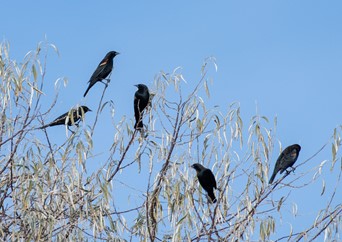
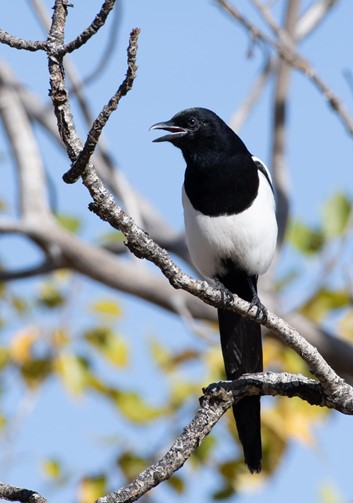
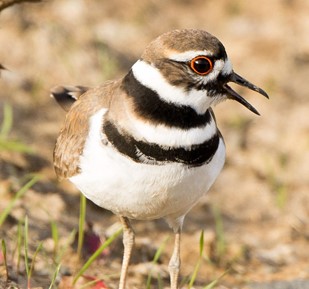
Summer Birds
Fourteen of the birds observed in 2020 are present primarily in summer. They typically spend winters further south. Many are insect-eaters so can’t survive the winters here, making this habitat particularly important for both the birds and birders. Summer residents include black-chinned hummingbird, western wood-pewee, western kingbird, warbling vireo, violet-green swallow, bank swallow, barn swallow, chipping sparrow, Bullock’s oriole, orange-crowned warbler, western tanager, and lazuli bunting. The bunting mostly uses shrubs in the open areas, but all these other species typically nest in the trees and hunt over the open areas.
Barn swallows may build their mud nests under the eaves of the buildings while violet-green swallows nest in cavities or nest boxes and bank swallows nest in banks along the Boise River. Swallows tend to nest in colonies, with bank swallows forming the larger colonies, violet-green swallows small colonies, and barn swallows either singly or in small colonies. Although hummingbirds are mostly associated with nectar, they also eat a large number of insects. They will feed on some of the flowers in the infield and nearby grounds, catch insects, and nest in the nearby trees.
Osprey are a migratory raptor, wintering further south and eating mostly fish. The Boise area is cold enough that finding enough open water for fishing is an iffy proposition in the winter. It’s not clear if the infield pond is large enough for osprey to fish, but they fly over the area from the Boise River. Black-necked stilts work the shallower areas of the pond, picking small insects and other invertebrates off the water surface or the bottom of the pond.
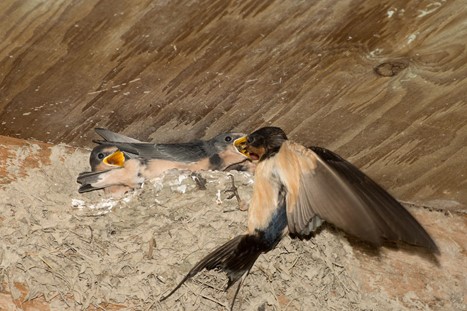
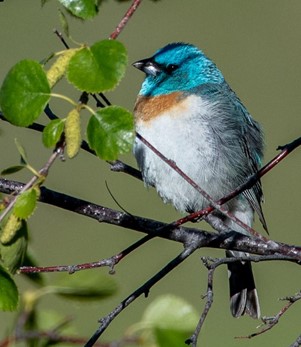
Winter Birds
Eleven species of birds are present more in winter than at other times of the year. Wintering ducks documented so far include gadwall, American wigeon, lesser scaup, ring-necked duck, bufflehead, and cinnamon teal. The songbirds that winter here are mostly elevational migrants, summering in the mountains and wintering in the valleys. These include red-breasted nuthatch, brown creeper, dark-eyed junco, white-crowned sparrow, and yellow-rumped warbler. White-crowned sparrows mostly nest much further north in northern Idaho, Canada, and Alaska before coming here to winter. Most yellow-rumped warblers winter further south but a few stick around the Boise area all winter long.
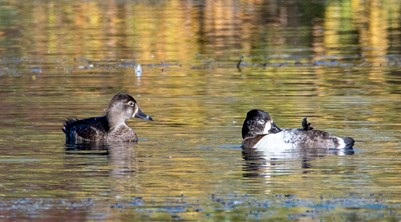
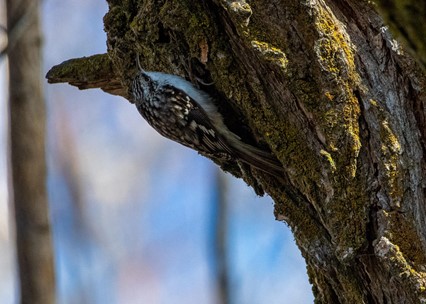
Other Possible Birds
Since the Les Bois infield has been birded only three times, there are several species present in the area that may occur in or near the infield. American kestrel, American goldfinch, and lesser goldfinch are year-round residents in the Boise area. The infield contains sunflowers and thistles that typically attract goldfinches. American kestrel is a small falcon that eats large insects and small rodents likely present in the infield. Cliff swallows are common summer birds that could build their mud nests under human structures, such as the grandstand. They commonly nest under bridges along the Boise River.
Since we’ve seen black-necked stilts, it’s likely that American avocets could occur as birders commonly see these two species together in places such as Blacks Creek Bird Reserve and Indian Creek Reservoir in summer. Great egrets tend to frequent the same areas as great blue herons but are more commonly seen during spring and fall migration. Additional duck species, such as green-winged teal and common goldeneye, may use the pond in winter. It’s not clear if the marshy area is large enough, but if it is, it could support marsh wrens, Virginia rails, and sora. We typically hear these species and rarely see them, although marsh wrens are more obvious during the breeding season.